
01
DAC‘s Emergence and Advantages
Cancer therapeutics need to balance efficacy and safety, even targeted chemotherapy does not always only kill abnormal cancer cells, and non-specific toxicity can lead to a low therapeutic index and side effects.
The technology of Proteolysis-targeting chimeras (PROTACs), which achieve therapeutic effects by promoting the degradation of target proteins, is rapidly revolutionizing the fields of biology and medicinal chemistry, but the physicochemical properties of PROTACs are also associated with poor DMPK characteristics and low bioavailability.
As an alternative means to achieve effective delivery of chimeric degraders in vivo, Degrader-antibody conjugates (DACs) have emerged, offering several potential advantages over the in vivo administration of PROTAC molecules:
(1) Able to deliver chimeric degraders with poor physicochemical or DMPK properties in vivo (especially those using E3 ligases other than CRBN);
(2) Avoid complex formulation;
(3) Able to target specific tumors or tissues through DACs with the PROTAC molecules of interest.
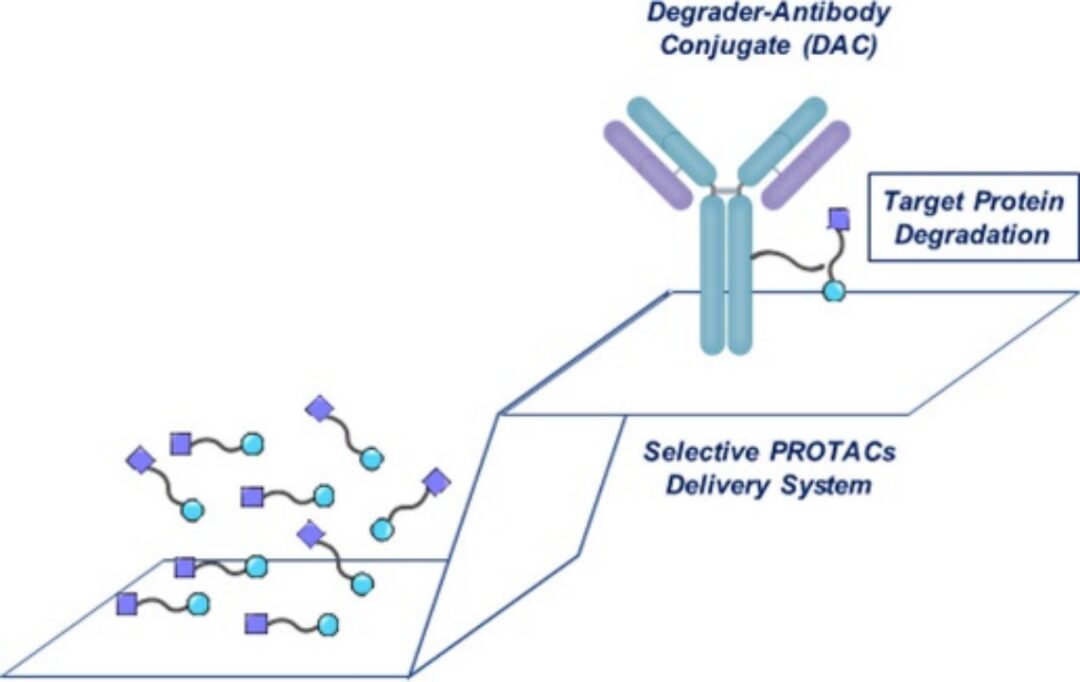
02
DAC Composition and Mechanism
DAC consists of mAb, linker, and PROTAC payload components.
In principle, the structural composition of ADCs and DACs is similar, with the difference that typically single-functional small molecules are used for ADCs, while PROTACs are used for DACs. Antibodies are key components for specifically binding and delivering payloads (such as small molecule toxins and PROTACs) to manipulate (or kill) and degrade target proteins. The prerequisites for antibodies are (1) specific interactions with clear antigens that have high tumor expression and limited normal cell expression; (2) the ability to maintain their characteristics, such as stability, internalization capability, and binding to linkers and payloads; (3) high binding specificity with the targeted antigens.
Linkers are divided into two main types: the first is cleavable linkers with three types of release mechanisms: lysosomal protease-sensitive (peptide), acid-sensitive (hydrazone), and glutathione-sensitive (disulfide) linkers; the second is non-cleavable linkers (like thioether) which show better stability in circulation compared to cleavable linkers. DAC payloads are designed for PROTACs and molecular glues. DACs require a drug-antibody ratio (DAR) greater than 4, which may affect the conjugation and pharmacokinetics of DAC.
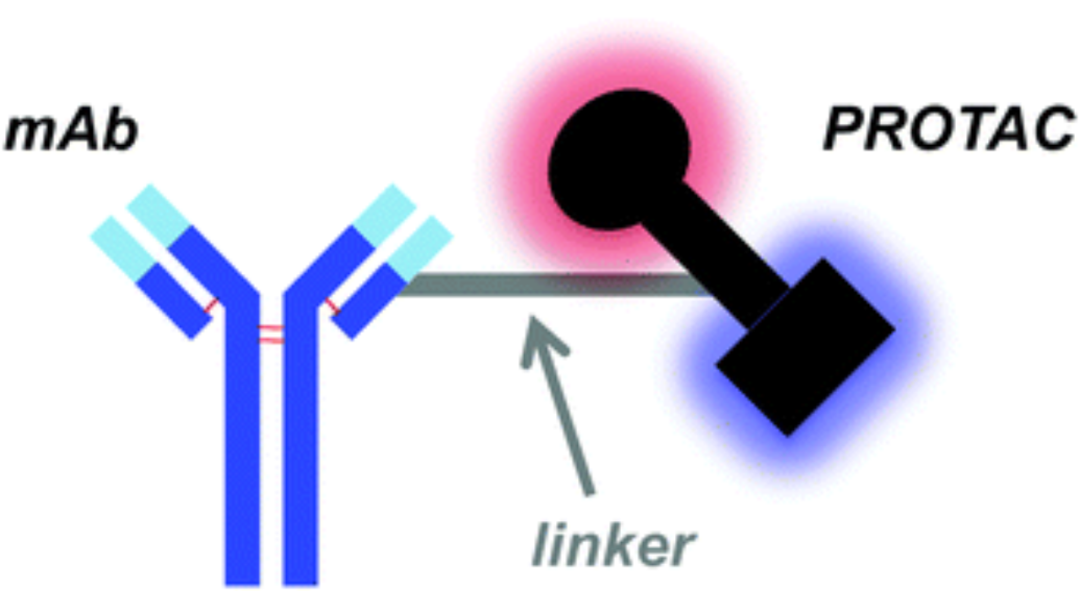
Figure Caption: DAC Composition
DAC and ADC mechanisms are fundamentally similar. After administration, the overall DAC should maintain systemic stability as much as possible to prevent premature release of PROTAC and circulation. Then, the antibody portion of DAC recognizes tumor-associated antigens on the cell surface. The DAC-antibody complex is internalized via receptor-mediated endocytosis. Within the cell, the complex fuses with endosomes and is transported to activated lysosomes. In the proteolytic and acidic environment, the complex linker is degraded, and the payload (PROTAC) is subsequently released into the cytoplasm. Depending on the intracellular targets of DAC, TPD can be induced.
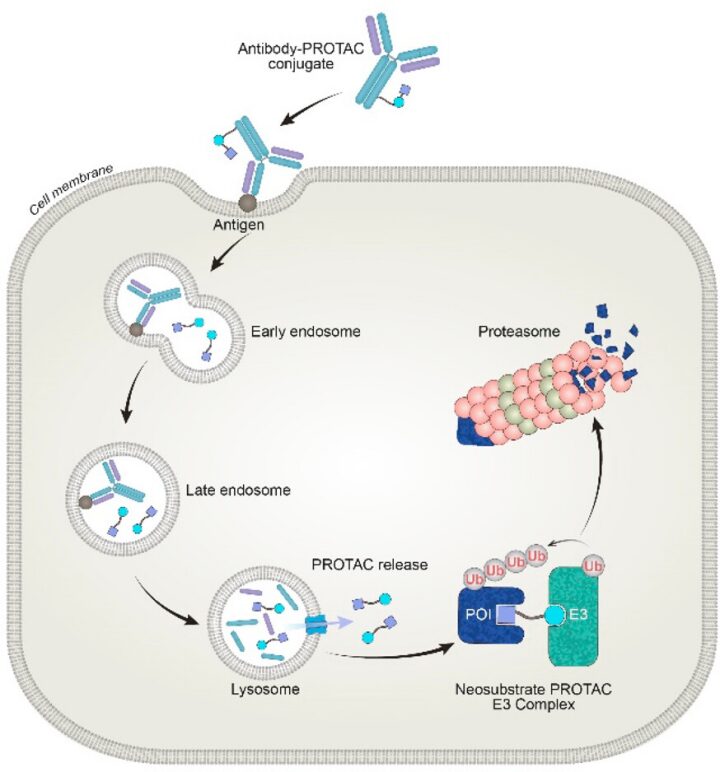
Figure Caption: DAC Mechanism
03
Targeting BRD4‘s DAC
In early 2020, Nature published the earliest example of DAC: a new disulfide bond-containing cleavable linker conjugated a VHL-based efficient degrader of bromodomain-containing protein 4 (BRD4) (GNE-987) to an antibody targeting CLL1 (DAC 1).
Optimized DAC 2 exhibited strong dose-dependent in vivo efficacy in HL-60 and EOL-1 acute myeloid leukemia (AML) xenograft models after a single intravenous administration, with experimental results demonstrating for the first time that degrader-antibody conjugates can overcome poor PROTAC PK characteristics, achieve acceptable PROTAC lysosomal stability, and confer appropriate antigen-based targeting, while also proving that the antibody linker is appropriately cleaved from the hydroxyl of the VHL binding fragment of PROTAC, allowing the released payload to have unobstructed bioactivity.

Figure Caption: Targeting BRD4’s DAC, Structures of Conjugates 1 and 2; Mechanism of Conjugate 2.
04
Targeting Erα‘s DAC
Targeting Erα’s DAC degrades estrogen receptor α (ERα) nuclear transcription factor by forming a ternary complex with the apoptosis protein X-linked inhibitor of apoptosis (XIAP) E3 ligase, using a Val-Cit cleavable linker and phenol-ether payload conjugated to a HER2-targeting mAb.
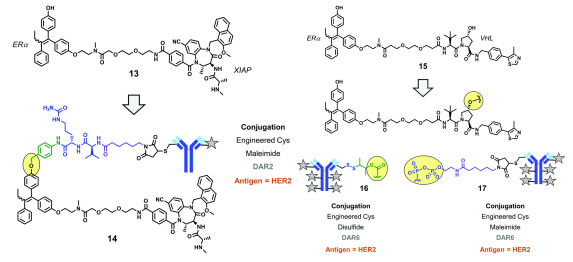
05
Targeting TGFβR2, BRM’s DAC
Using lysine as a linker connected to an non-cleavable amide linker on HER2, CRBN-linked DAC 18 demonstrated the required level of TGFβR2 degradation after 24 and 48 hours.
The second example is BRM protein degrader, BRM protein, also known as SMARCA2 (SWI/SNF-related, matrix-associated, actin-dependent regulator of chromatin subfamily A member 2), is present in various human diseases, including cancer.This degrader was initially developed by Arvinas and Genentech in 2019. Genentech further demonstratedDAC 20, mAb using a disulfide bond-based linker binding to the CD22 cell surface receptor, introducing various linker chemistries, with xenograft data indicating efficient antigen-dependent degradation targeting BRM protein levels.
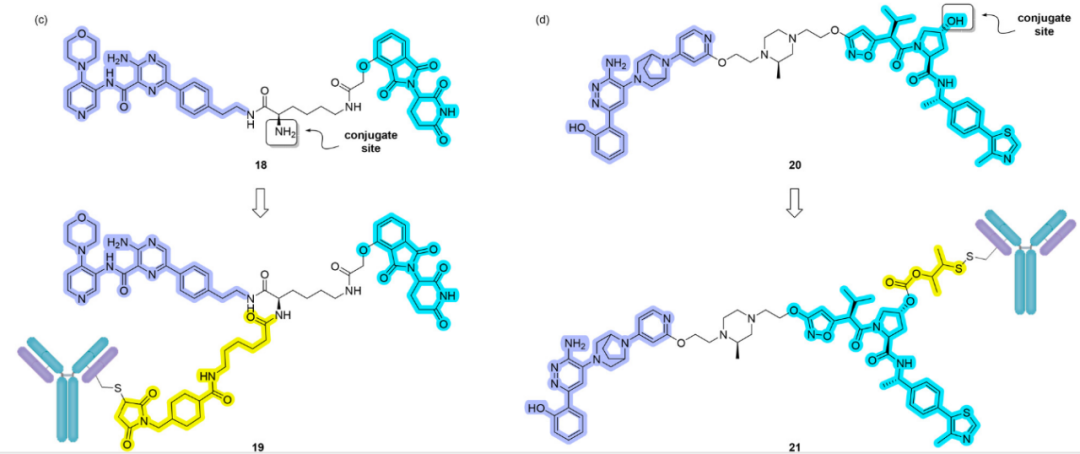 Figure Caption: Targeting TGFβR2, BRM’s DAC
Figure Caption: Targeting TGFβR2, BRM’s DAC
06
Targeting GSPT1’s DAC
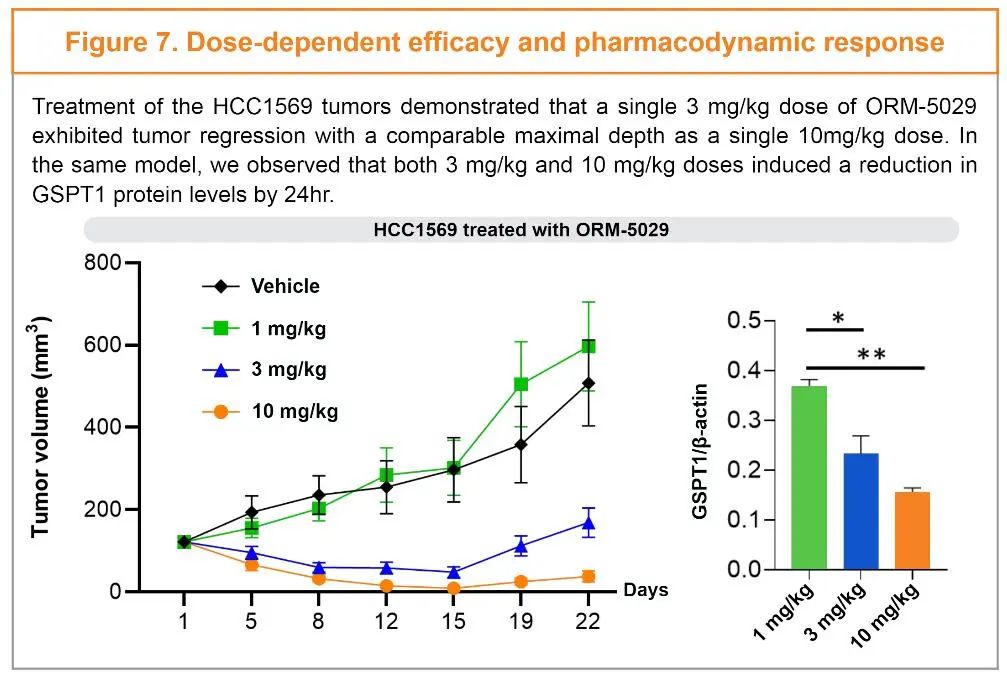 Figure Caption: Preclinical Data of ORM-5029
Figure Caption: Preclinical Data of ORM-5029
07
DAC Structural Design Considerations
Although some strategies used for ADCs can be applied to the preparation and delivery of bioactive DACs, the construction of DACs also has additional challenges. Compared to the broad cytotoxic payloads used for ADCs, degraders typically exhibit more targeted bioactivity with respect to specific cancers or tissue cell types. Therefore, the antigens of DACs must not only meet the internalization and transport standards of ADCs but should also be highly expressed on tumors, tissues, or other cells sensitive to degraders.
Due to the slightly weaker nature of chimeric degraders compared to cytotoxic ADC payloads, a higher loading may be required relative to ADCs to achieve similar efficacy (i.e., DAR value greater than 4). Due to their chimeric nature, DAC PROTAC payloads are typically larger or more lipophilic than ADC cytotoxic molecules (especially cell-permeable molecules). When PROTACs are attached to antibodies, these differences amplify aggregation and pharmacokinetic issues, potentially requiring new linker designs and conjugation methods, rather than those used in the ADC field.
Moreover, many reported chimeric degraders lack the chemical groups available for covalent linking with cleavable linkers. In such cases, it must be carefully considered whether to purposefully incorporate the necessary chemical groups into the degrader structure or to utilize new ADC linking methods leveraging existing degrader functional groups, such as hydroxyl/ phenolic groups.
08
DAC Development Is Still Full of Risks
Dosing Overload. One theoretical advantage of PROTACs is low dosing, as PROTAC-driven degradation is “event-driven” rather than “occupancy-driven”: only transient target binding is required. After binding and ubiquitin transfer, the drug dissociates and enzymatically moves to the next target. In preclinical studies, very low PROTAC doses can significantly reduce protein levels. Arvinas’ phase II drug is orally bioavailable, yet the dosing for their androgen receptor degrader ARV-110 is 420 mg, while the dosing for their estrogen receptor degrader is 200 and 500 mg. Due to their low permeability and solubility, the phenomenon of dosing overload arises. Arvinas reported sufficient dose-dependent plasma drug concentrations, with both drugs showing good safety in phase I, as well as antitumor activity. However, high doses imply higher manufacturing costs, and PROTACs already have high manufacturing costs due to their multi-step synthesis.
Potential Side Effects. Toxicology is another bottleneck in PROTAC development, with the potential for both targeted and off-target side effects. The problem lies at the E3 ligase end, if E3 docks in a manner similar to IMiD, PROTACs may degrade unexpected substrates, which poses potential unexpected risks.
Limitations of Molecular Glues. Given the dosing and oral availability challenges of PROTACs, some companies are concentrating on another type of degrader, namely molecular glues, which are “monovalent” small molecules that bind only to E3 ligases, rather than the bivalent PROTACs that bind both ligases and targets simultaneously, with Celgene’s lenalidomide being a typical example. However, the downside of molecular glues is that they are difficult to target selected disease-related targets for degradation, and their discovery must be reverse-engineered, screening E3-binding molecules to achieve the desired phenotype, or screening against large protein combinations and then figuring out which proteins they are degrading.
09
DAC Future Development
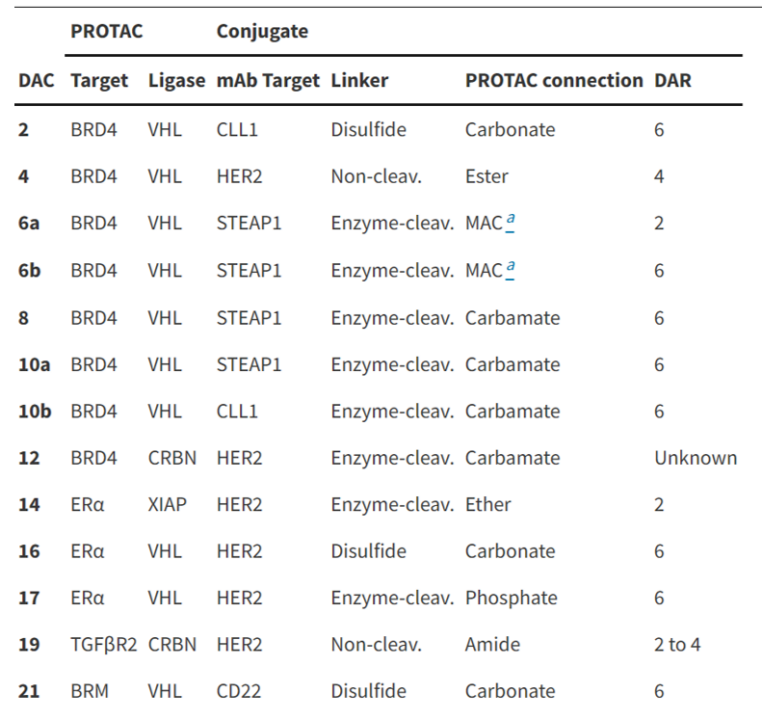
Figure Caption: Currently Developed DACs and Their Components
 References
References
1.Dragovich PS. Degrader-antibody conjugates. Chem Soc Rev. 2022 May 23;51(10):3886-3897. doi: 10.1039/d2cs00141a. PMID: 35506708.
2.Hong KB, An H. Degrader-Antibody Conjugates: Emerging New Modality. J Med Chem. 2023 Jan 12;66(1):140-148. doi: 10.1021/acs.jmedchem.2c01791. Epub 2022 Dec 29. PMID: 36580273.
3.Dragovich PS, Pillow TH, Blake RA, Sadowsky JD, Adaligil E, Adhikari P, Chen J, Corr N, Dela Cruz-Chuh J, Del Rosario G, Fullerton A, Hartman SJ, Jiang F, Kaufman S, Kleinheinz T, Kozak KR, Liu L, Lu Y, Mulvihill MM, Murray JM, O’Donohue A, Rowntree RK, Sawyer WS, Staben LR, Wai J, Wang J, Wei B, Wei W, Xu Z, Yao H, Yu SF, Zhang D, Zhang H, Zhang S, Zhao Y, Zhou H, Zhu X. Antibody-Mediated Delivery of Chimeric BRD4 Degraders. Part 2: Improvement of In Vitro Antiproliferation Activity and In Vivo Antitumor Efficacy. J Med Chem. 2021 Mar 11;64(5):2576-2607. doi: 10.1021/acs.jmedchem.0c01846. Epub 2021 Feb 17. PMID: 33596073.
4.Dragovich PS, Adhikari P, Blake RA, Blaquiere N, Chen J, Cheng YX, den Besten W, Han J, Hartman SJ, He J, He M, Rei Ingalla E, Kamath AV, Kleinheinz T, Lai T, Leipold DD, Li CS, Liu Q, Lu J, Lu Y, Meng F, Meng L, Ng C, Peng K, Lewis Phillips G, Pillow TH, Rowntree RK, Sadowsky JD, Sampath D, Staben L, Staben ST, Wai J, Wan K, Wang X, Wei B, Wertz IE, Xin J, Xu K, Yao H, Zang R, Zhang D, Zhou H, Zhao Y. Antibody-mediated delivery of chimeric protein degraders which target estrogen receptor alpha (ERα). Bioorg Med Chem Lett. 2020 Feb 15;30(4):126907. doi: 10.1016/j.bmcl.2019.126907. Epub 2019 Dec 18. PMID: 31902710.
Scan the WeChat QR code to add the editor of the Bioproducts Circle, those who meet the criteria can join the
Bioproducts WeChat group!
Please indicate: Name + Research Direction!


The articles reprinted by this public account are for the purpose of conveying more information, and clearly indicate the source and author. If the media or individuals do not wish to be reprinted, please contact us ([email protected]), and we will immediately delete it. All articles only represent the author’s views and do not represent the position of this site.
